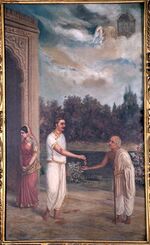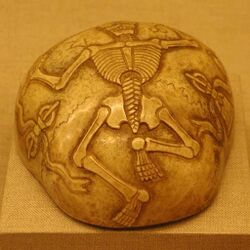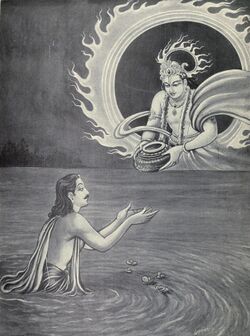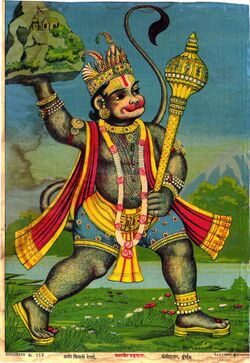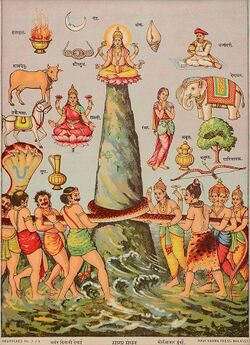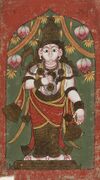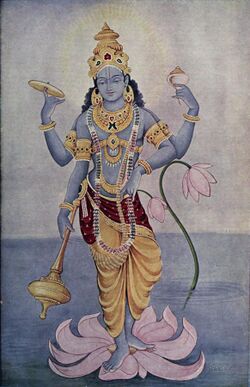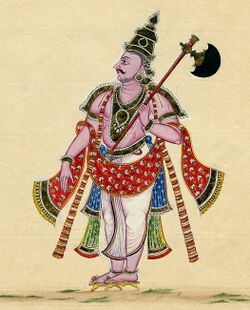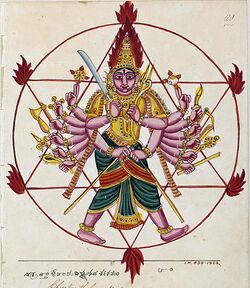List of mythological objects (Hindu mythology)
Topic: Religion
 From HandWiki - Reading time: 17 min
From HandWiki - Reading time: 17 min
This list has no precise inclusion criteria as described in the Manual of Style for standalone lists. (March 2017) |
Real objects encompass a variety of items (e.g. weapons, armor, clothing) found in Hinduism.
Armour
|
Containers
- Kalasha - The kalasha is considered a symbol of abundance and "source of life" in the Vedas. It is referred to as "overflowing full vase" in the Vedas. The Kalasha is believed to contain amrita, the elixir of life, and thus is viewed as a symbol of abundance, wisdom, and immortality. The Kalasha is often seen in Hindu iconography as an attribute, in the hands of Hindu deities like the creator god Brahma, the destroyer god Shiva as a teacher, and the goddess of prosperity Lakshmi.
- Kamandalu or kamandal or kamandalam - It is an oblong water pot made of a dry gourd (pumpkin) or coconut shell, metal, wood of the Kamandalataru tree,[2] or from clay, usually with a handle and sometimes with a spout. The kamandalu is used in Hindu iconography, in depiction of deities related with asceticism or water. It is, thus, viewed as a symbol of ascetism in Hinduism.[3] Adi Shankaracharya’s ashtotaram hymn praises Shiva whose hand is adorned with the kamandalu. Other deities like the fire-god Agni and the preceptor of the gods, Brihaspati, are depicted carrying the kamandalu.[4][5]
- Kapala - A kapala (Sanskrit for "skull") or skullcup is a cup made from a human skull used as a ritual implement (bowl) in both Hindu and Buddhist Tantra.
- Kumbha - A kumbha is a type of pottery in India. It symbolises the womb, thus it represents fertility, life, generative power of human beings and sustenance and is generally associated with devis, particularly Ganga.[6]
Dispensers
- Akshaya Patra - Akshayapatra (means an inexhaustible vessel), is an object from Hindu theology. It was a wonderful vessel given to Yudishtira by the Lord Surya which provided a never-failing supply of food to the Pandavas every day.[7]
- Akshaya Tunir - inexhaustible quiver of arrows of Arjuna.
Flags
- Garuda Dhwaja - The flag of Vishnu.
- Indra Dhwaja - The flag of Indra. Also a festival of Indra.
- Kakkai kodi - The flag of Jyestha, goddess of inauspicious things and misfortune.
- Kapi Dhwaja or Vanara dwaja (monkey flag) - The flag of Arjuna in the Mahabharata, in which the Lord Hanuman himself resided.[8]
- Makaradhvaja - The flag of Kama, god of love.
- Seval Kodi - The war flag of Lord Murugan, god of war. It depicts the rooster, Krichi.
Flora
Herbs & Plants
- Ausadhirdipyamanas - Healing plants. Used for healing and rejuvenations in battles. These are used by the Ashvins.
- Eraká grass - The grass that grew from the cast away powdered iron-bolt belonging to Samba. It was used to destroy the Yadu race, as it miraculously turned into an iron-bolt in the hands of its wielders.
- Kusha grass/Darbha grass - The Kusha grass is specifically recommended by Lord Krishna in the Bhagavad Gita as part of the ideal seat for meditation.
- Padma - Padma (The sacred lotus) is an aquatic plant that plays a central role in Indian religions such as Hinduism, Buddhism, Sikhism, and Jainism. Hindus revere it with the gods Vishnu, Brahma and to a lesser degree Kubera, and the goddesses Lakshmi and Saraswati. Often used as an example of divine beauty and purity.
- Saugandhika flower was a lotus flower which was sought after by Bhima (for Draupadi) during the Pandavas exile. It was found in Kubera's pond.
- Sanjeevani - Sanjeevani is a magical herb which has the power to cure any malady. It was believed that medicines prepared from this herb could revive a dead person.
- Tulsi - Tulsi (or Tulasi, Holy basil) is a sacred plant in Hindu belief. Hindus regard it as an earthly manifestation of the goddess Tulsi; she is regarded as a great worshipper of the god Vishnu.
Trees
- The Tree of Jiva and Atman appears in the Vedic scriptures, predating current Hinduism, as a metaphysical metaphor concerning the soul.
- Sacred grove
- Caitraratha, the grove of Kubera
- Ekachakra
- Nakshatravana
- Vrindavan
- Sacred Trees
- Amalika - The veneration of the amla tree in particular is due to the belief that the god Vishnu resides in and near the tree, particularly on Amalaka Ekadashi.
- Ashoka tree - The ashoka tree is closely associated with the yakshi mythological beings.
- Atti/Gular Fig (Sanskrit: uḍumbara) - In the Atharva Veda, this fig tree is given prominence as a means for acquiring prosperity and vanquishing foes.
- Bilva tree - Bilwa tree is a sacred tree and used to worship Lord Shiva.
- Kadamba - The kadamba is mentioned in the Bhagavata Purana. In North India, it is associated with Krishna while in the south it is known as "Parvati’s tree". The kadamba tree is also associated with a tree deity called Kadambariyamman.
- Parijata (also Nyctanthes arbor-tristis - The divine flowering tree with blossoms that never fade or wilt - taken to Indraloka by the Devas.
- Sala tree - In Hindu tradition, the sal tree is said to be favoured by Vishnu. It is also associated with salabhanjika or shalabhanjika (also known as madanakai, madanika or shilabalika).
- Tree of Life
- Akshayavat or Akshay Vat (Indestructible Banyan Tree) - It is a sacred fig tree. The sage Markandeya asked Lord Narayana to show him a specimen of the divine power. Narayana flooded the entire world for a moment, during which only the Akshayavat could be seen above the water level.
- Wishing tree
- Kalpavriksha (also Kalpataru, Kalpadruma or Kalpapādapa) - It is a wish-fulfilling divine tree in Hindu history.
- World Tree
- Ashvattha (also Assattha) - A sacred tree for the Hindus and has been extensively mentioned in texts pertaining to Hinduism, mentioned as 'peepul' (Ficus religiosa) in Rig Veda mantra I.164.20. Buddhist texts term the tree as Bodhi tree, a tree under which Gautama Buddha meditated and gained enlightenment.
Gardens
- Ashok Vatika was a garden in Lanka, the Kingdom of demon king, Ravana.
- Nandana is the celestial garden in Amaravati (also known as Indra Loka), planted with sacred trees and sweet-scented flowers.
Forests
- Dharmāranya - a sacred grove; a forest in Madhyadesa into which Dharma retired.
- Dandakaranya
- Dvaita Forest
- Himavanta Forest
- Kamyaka Forest
- Khandava Forest
- Madhu Forest
- Naimisha Forest
Jewelry and ornaments
|
Musical instruments
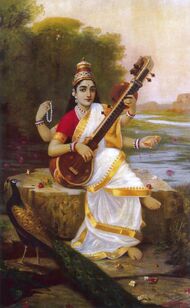 Goddess Saraswati depicted playing the veena
|
Substances
- Amrita - The nectar produced from the Samudra manthan, which upon consuming, granted the gods immortality.
- Halahala (also called 'kalakuta') - The Samudra manthan process released a number of things from the Ocean of Milk. One was the lethal poison known as Halahala. This terrified the gods and demons because the poison was so powerful that it could destroy all of creation. Shiva consumed the poison in an act to protect the universe.
- Soma (Sanskrit) or Haoma (Avestan) - It is described as being prepared by extracting juice from the stalks of a certain plant. In both Vedic and Zoroastrian tradition, the name of the drink and the plant are the same, and also personified as a divinity, the three forming a religious or mythological unity.
Treasures
- Mahāpadma refers to a legendary treasure in Hindu history.
- Navaratna - The sacred and royal "nine gems".
- Nidhi (also called Nidhana, Nikhara, and Sevadhi) - In Hinduism, Nidhi, that is, a treasure, constitutes of nine treasures (nawanidhi) belonging to Kubera, god of wealth.
- Ratnas - The 14 gems/treasures produced during the Samudra manthan.
Vehicles
|
Weapons
- Anrita - The name of one of the mystical weapons delivered to Ráma by Viswámitra, as mentioned in the Rámáyana.
- Ayudhapurusha - The anthropomorphic depiction of a divine weapon in Hindu art. Ayudhapurushas are sometimes considered as partial incarnates of their divine owners.
- Indra's net - The net was one of the weapons of the sky-god Indra, used to snare and entangle enemies. The net also signifies magic or illusion.
- Shiva Kaakam - An unconquerable weapon of Lord Shiva.
Shastra
- Ankusha (also Elephant Goad) - An elephant goad is one of the eight auspicious objects known as Astamangala. Ankusha is also an attribute of many Hindu gods, including Ganesha.
- Balachita - The Halayudha, is a plough used as a weapon by Balaram, brother of Krishna.
- Chentu - A horse whip which looks like a crooked stick, and is a typical attribute of Aiyanar, Krishna in his aspect as Rajagopala, and Shiva with Nandi.
Astra
Miscellaneous
See also
References
|
Licensed under CC BY-SA 3.0 | Source: https://handwiki.org/wiki/Religion:List_of_mythological_objects_(Hindu_mythology)1 | Status: cached on July 24 2024 23:14:58↧ Download this article as ZWI file
 KSF
KSF